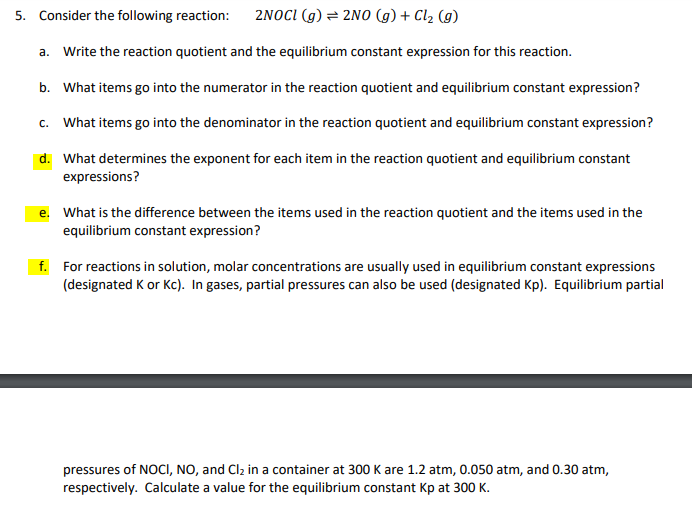5. Consider the following reaction: 2NOCI (g) = 2NO (g) + Cl2 (g) a. Write the reaction quotient and the equilibrium constant expression for this reaction. b. What items go into the numerator in the reaction quotient and equilibrium constant expression? c. What items go into the denominator in the reaction quotient and equilibrium constant expression? d. What determines the exponent for each item in the reaction quotient and equilibrium constant expressions? e. What is the difference between the items used in the reaction quotient and the items used in the equilibrium constant expression? f. For reactions in solution, molar concentrations are usually used in equilibrium constant expressions (designated K or Kc). In gases, partial pressures can also be used (designated Kp). Equilibrium partial
5. Consider the following reaction: 2NOCI (g) = 2NO (g) + Cl2 (g) a. Write the reaction quotient and the equilibrium constant expression for this reaction. b. What items go into the numerator in the reaction quotient and equilibrium constant expression? c. What items go into the denominator in the reaction quotient and equilibrium constant expression? d. What determines the exponent for each item in the reaction quotient and equilibrium constant expressions? e. What is the difference between the items used in the reaction quotient and the items used in the equilibrium constant expression? f. For reactions in solution, molar concentrations are usually used in equilibrium constant expressions (designated K or Kc). In gases, partial pressures can also be used (designated Kp). Equilibrium partial
Chemistry for Engineering Students
4th Edition
ISBN:9781337398909
Author:Lawrence S. Brown, Tom Holme
Publisher:Lawrence S. Brown, Tom Holme
Chapter12: Chemical Equilibrium
Section: Chapter Questions
Problem 12.40PAE: Because carbonic acid undergoes a second ionization, the student in Exercise 12.39 is concerned that...
Related questions
Question
I only need help with D E and F please

Transcribed Image Text:5. Consider the following reaction:
2NOCI (g) = 2N0 (g) + Cl2 (g)
a. Write the reaction quotient and the equilibrium constant expression for this reaction.
b. What items go into the numerator in the reaction quotient and equilibrium constant expression?
c. What items go into the denominator in the reaction quotient and equilibrium constant expression?
d. What determines the exponent for each item in the reaction quotient and equilibrium constant
expressions?
e. What is the difference between the items used in the reaction quotient and the items used in the
equilibrium constant expression?
f. For reactions in solution, molar concentrations are usually used in equilibrium constant expressions
(designated K or Kc). In gases, partial pressures can also be used (designated Kp). Equilibrium partial
pressures of NOCI, NO, and Clz in a container at 300 K are 1.2 atm, 0.050 atm, and 0.30 atm,
respectively. Calculate a value for the equilibrium constant Kp at 300 K.
Expert Solution
This question has been solved!
Explore an expertly crafted, step-by-step solution for a thorough understanding of key concepts.
This is a popular solution!
Trending now
This is a popular solution!
Step by step
Solved in 3 steps

Knowledge Booster
Learn more about
Need a deep-dive on the concept behind this application? Look no further. Learn more about this topic, chemistry and related others by exploring similar questions and additional content below.Recommended textbooks for you

Chemistry for Engineering Students
Chemistry
ISBN:
9781337398909
Author:
Lawrence S. Brown, Tom Holme
Publisher:
Cengage Learning

Chemistry: An Atoms First Approach
Chemistry
ISBN:
9781305079243
Author:
Steven S. Zumdahl, Susan A. Zumdahl
Publisher:
Cengage Learning


Chemistry for Engineering Students
Chemistry
ISBN:
9781337398909
Author:
Lawrence S. Brown, Tom Holme
Publisher:
Cengage Learning

Chemistry: An Atoms First Approach
Chemistry
ISBN:
9781305079243
Author:
Steven S. Zumdahl, Susan A. Zumdahl
Publisher:
Cengage Learning


Chemistry
Chemistry
ISBN:
9781305957404
Author:
Steven S. Zumdahl, Susan A. Zumdahl, Donald J. DeCoste
Publisher:
Cengage Learning

Introductory Chemistry: A Foundation
Chemistry
ISBN:
9781337399425
Author:
Steven S. Zumdahl, Donald J. DeCoste
Publisher:
Cengage Learning

Chemistry & Chemical Reactivity
Chemistry
ISBN:
9781133949640
Author:
John C. Kotz, Paul M. Treichel, John Townsend, David Treichel
Publisher:
Cengage Learning